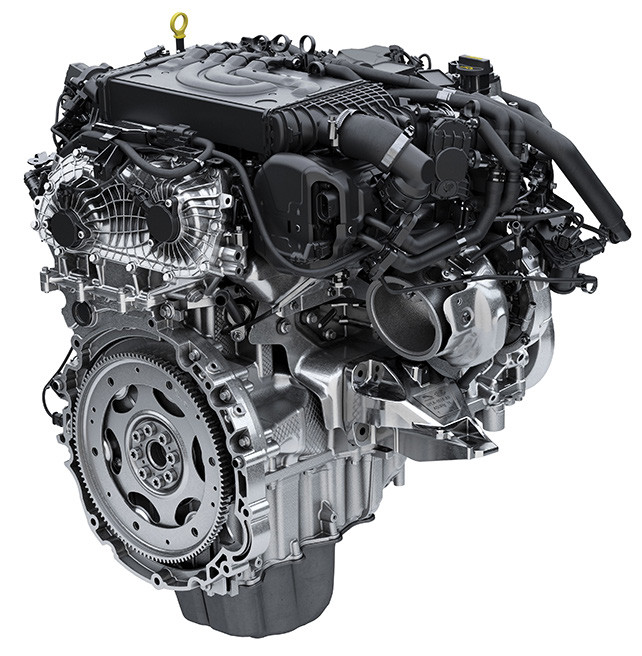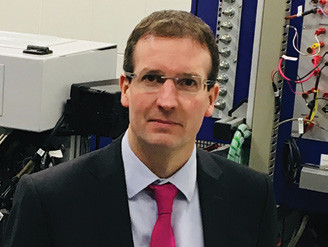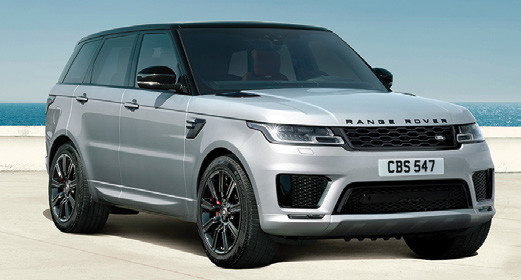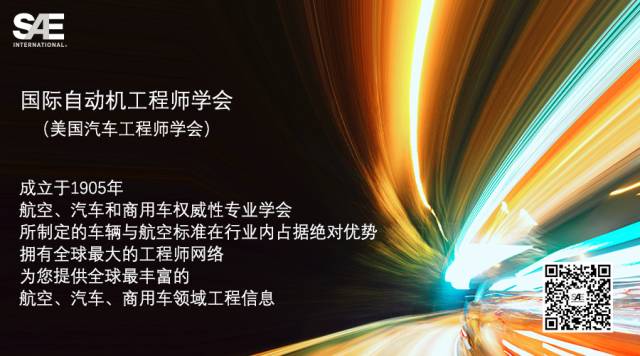
 捷豹路虎发动机项目首席工程师 Jon Harris
捷豹路虎发动机项目首席工程师 Jon Harris 新款路虎揽胜运动 HST 将成为捷豹路虎首款应用全新 3.0 L 直列六缸电动增压/涡轮增压发动机的车型。
新款路虎揽胜运动 HST 将成为捷豹路虎首款应用全新 3.0 L 直列六缸电动增压/涡轮增压发动机的车型。
据称,与现行的 V 型六缸发动机相比,全新 3.0 L 直列六缸发动机的输出功率和扭矩分别高达 294kW(394 hp)和 550 N·m(406 lb·ft),达到 欧6B 排放标准,且重量还降低了 12 千克(26.4 磅)。
近日,捷豹路虎(Jaguar Land Rover)直列六缸发动机重新登陆公司最新揽胜(Range Rover)系列车型的决定可能会让市场感到些许惊讶,但事实上这种发动机自八年前问世以来,一直位列捷豹路虎的产品开发名单。据了解,新款路虎揽胜的主要卖点在于性能提升,而捷豹路虎显然认为I-6 直列六缸发动机相交其他 V 型排列六缸发动机具有明显优势。
这款全新 3.0 升 I-6 发动机沿用了捷豹路虎Ingenium 系列I-4 发动机(单缸容量 500cc)的模块化设计,输出功率和扭矩分别高达 294 kW(394 hp)和550 N·m(406 lb·ft),搭配全新路虎揽胜运动 HST(顶配版本)完全可满足 EU6b 排放要求,不输任何其他以性能著称的SUV。值得特别提起的是,该发动机搭配了一款电动增压器,可借助车辆的48V 轻度混合动力再生系统提供动力,仅需 0.5 秒即可达到65000 rpm 的转速。这种设计“几乎消除”了双涡管涡轮增压器中常见的滞后问题,可在加速瞬间为车辆提供300 Nm/s 的扭矩加速度。
数年之前,路虎已决定逐步弃用购自福特(Ford)或 PSA 的发动机,并在 2020 年起为所有车型提供电动版选项。无论从哪方面讲,这款I-6 发动机的问世都将协助路虎实现这些目标。据了解,这款I-6 发动机将首先登陆新款路虎揽胜运动HST SUV 中,生产则将在公司 Wolverhampton工厂中专门开辟一条新产线进行。《汽车工程》欧洲区编辑Stuart Birch 针对这款直列六缸发动机的研发细节,采访了捷豹路虎发动机项目总工程师Jon Harris。
Ingenium 是一个支持不同燃料选项(汽油和柴油)的模块化发动机系列,而这款I-6 发动机是否也是基于 Ingenium概念设计的呢?这又是从什么时候开始的?
Harris:这款六缸汽油发动机的确是基于Ingenium 发动机系列概念设计的,我们早在八年前就已经开始了。Ingenium系列的重心最初是在四缸汽油发动机和2.0 升柴油发动机上,但 3.0 升 I-6 发动机也一直在我们的计划中,而且从一开始也规划了专门的生产设施用地。
捷豹路虎现在用的是48V 轻混动力系统。对此,您可以具体介绍一下吗?
Harris:这款发动机配备了皮带驱动的集成式起动机/发电机(BSG)以取代传统配置中常见的交流发电机。具体来说,BSG可以为车辆提供电力,并将车辆超速运行期间损失的能量存储在一个48V 电池中,并在后续行驶中通过皮带传动系统将这部分能量转化为额外的扭矩,帮助内燃机提高运转效率、优化运行状态,从而提高车辆的燃油经济性。BSG系统还有助于发动机实现“无缝”启停,用户在整个过程中几乎无法察觉启停切换。
捷豹路虎决定为这款I-6 发动机搭配电动增压器和双涡管涡轮增压器,这主要是为什么呢?
Harris:法雷奥是我们的一级供应商合作伙伴,为我们提供电动增压系统,从而配合主发动机涡轮增压器的工作,将压缩空气输送到发动机。捷豹路虎一向以出色的车辆驾驶性能著称,而车辆驾驶性能在很大程度上是直接取决于发动机增压系统的。法雷奥电动增压器的主要作用是利用48V 系统中的能量,帮助压缩机在0.5 秒内加速至 65000 rpm,从而为车辆提供卓越的驾驶性能水平。
从四缸到六缸,公司为了实现这个转变进行了哪些工作?您能提供热效率方面的参数吗?
Harris:为了容纳额外两个气缸,但同时保证大多数次级部件的高度通用性,I-6模块化发动机架构采用了一套新的气缸盖、气缸体和曲轴。
此外,我们还对发动机的核心燃烧系统进行了充分优化,燃气旋转运动提高了40%,还升级了液压阀。此外,发动机顶部还直接集成了为增压空气系统准备的两级中冷系统。这样可以减少气量,并精确控制增压空气的温度,进而优化经济效率、减排效果和性能表现。新型Ingenium 汽油六缸发动机的汽车制动油耗率为229 g/kWh。
这款 I-6发动机是完全由捷豹路虎内部设计开发的吗?是否有借助外部公司的帮助?
Harris:I-6发动机完全是捷豹路虎公司在考文垂Whitley 工程中心内部设计完成的。
过去,V6 优于 I-6 发动机的主要原因之一是其在满足碰撞安全标准方面的优势。现在的情况还是这样吗?此外,由于I-6 发动机仅需要一个气缸盖和一组歧管,那么成本优势也是公司推I-6 发动机的原因之一吗?
Harris:在确定发动机配置时,直列和V 型发动机布局是一项非常重要的战略决策,并且需要考虑许多问题,比如如何进行改进?可以通用哪些车辆和发动机装配工艺?与模块化Ingenium 系列是否有协同作用?以及如何控制重量和成本等等。
如今,一些技术的发展是否也是捷豹路虎I-6 发动机成为可能的原因之一?比如这款发动机搭配的电动增压器。
Harris:为了提供世界一流的性能,我们的I-6 汽油发动机采用了许多高水平的先进技术,比如沿用了2.0 升 I-4 发动机搭配的液压连续可变气门升程系统。
喷油器的喷射压强已经升级为250 巴,点火线圈能量也提升至108 兆焦,而且车辆的 48V 电动增压器和双涡旋涡轮增压器将同时为发动机输送空气。
I-6 和V6 发动机的重量对比如何?功率输出和扭矩对比呢?
Harris:新款捷豹路虎发动机I-6 发动机与现行的 V6 发动机相比,重量减轻了 12 千克(26.4磅)。
与环保意义更加明显的V8 发动机相比,电气化 I-6 概念发动机是否在动力供应、NVH 和整体驾驶平顺性方面有巨大优势?
Harris:电气化I-6 发动机一直是捷豹路虎长期战略规划中的重要组成部分,我们希望引导过去驾驶V8 发动机车型的客户向电动I-6 发动机车型转型。
所有厂商都会寻找对标技术,这款I-6 发动机的功率输出、NVH、总体质量等参数都主要对标了哪些产品呢?
Harris:我们的技术团队在核心技术、性能、燃料经济性、NVH和重量等方面都与主要竞争对手进行了对标。未来,预计这款发动机也将给行业和其他竞争对手提供更多对标选择,共同促进行业发展。
柴油发动机的近况如何?捷豹路虎还会继续开发柴油发动机吗?大家对柴油发动机的排放问题是不是经常反应过度了(二氧化碳排放实际已经非常低了)?未来,在一个以混合动力为主的世界中,柴油发动机还有一席之地吗?
Harris:我们认为,柴油和汽油动力系统将与纯电动汽车并驾齐驱,继续发挥重要作用,这些产品也都是公司战略的重要组成部分。近些年来,我们听到了大量对柴油技术的误解,但事实上技术没有好坏,只有合适与否。我们应该根据客户的用车情况,为客户推荐最合适的动力系统。如今,我们对清洁柴油的投资已经初显成效,捷豹和路虎车型都是目前市面上最清洁的柴油车之一。
柴油发动机在 SUV车型中的优势更加明显,这种动力系统可以让客户享受游刃有余的扭矩输出及一系列附加功能,牵引能力更是尤为突出。
The all-new 3.0L I-6 delivers a claimed 294 kW (394 hp) and 550 N·m (406 lb·ft) while meeting the EU6b emission standard and still providing a 12-kg (26.4 lb) weight-saving vs. the outgoing V6.
The market may have been surprised by Jaguar Land Rover’s decision to offer the latest Range Rover with an I-6 gasoline engine, but it’s been on the company’s development list since the Ingenium engine series was conceived more than eight years ago. With refinement a salient Range Rover selling point, it was determined the I-6 had sufficient advantages over a V6 (including manufacture) to tip the balance in its favor.
Derived from the company’s modular (500cc per cylinder) Ingenium-series inline-4, the new 3.0-L I-6 produces 294 kW (394 hp) and 550 N·m (406 lb·ft) while meeting the EU6b emission standard when installed in the new Range Rover Sport HST (top), putting it well into the SUV muscle league. The new mill incorporates an electric supercharger powered by a 48V mild-hybrid regenerative system capable of spooling to 65,000 rpm in 0.5 seconds. It “virtually eliminates” lag from the engine’s twin-scroll turbocharger, delivering a torque rise rate during transient accelerations of up to 300 Nm/s.
With the decision to move away from outsourced (Ford and PSA) engines made several years ago, the new I-6 contributes to Land Rover’s commitment of delivering an electrified option on all new models from next year. It will appear first in the new Range Rover Sport HST, and is manufactured on a new line at JLR’s Wolverhampton facility. Automotive Engineering’s Europe Editor Stuart Birch spoke with JLR’s engine programs chief engineer Jon Harris for details on its development.
Ingenium is a multi-role (gasoline and diesel) modular engine range, but was a 6-cylinder gasoline envisioned from its concept, and if so when was that?
Harris: The 6-cylinder gasoline engine was envisaged from the conception of the Ingenium engine series more than eight years ago. Initial focus was put on the 4-cylinder gasoline and diesel 2.0L engines, but the [inline] 6-cylinder 3.0L engine was always planned and the factory footprint provisioned from the outset.
You are using a 48V mild hybrid system. Can you put some more detail on that?
Harris:The engine is fitted with a belt-driven integrated starter/generator (BSG) which replaces the alternator. The machine acts as the electrical energy supply system for the vehicle and stores lost energy in a 48V battery during a vehicle over-run condition. The energy can then be reapplied as torque assist through the belt drive system to allow the combustion engine to run in a more efficient, optimized state delivering improved fuel economy. The BSG system also facilitates seamless engine stop/start events that are almost imperceptible.
JLR decided to use an electric supercharger and twin-scroll turbocharger for the I-6; can you provide some detail about that strategy?
Harris: We have worked with Valeo as the Tier-1 supplier to deliver the electric supercharger system, which works alongside the main engine turbocharger to deliver pressurized air into the engine. Vehicle drivability is a key attribute for Jaguar Land Rover and the selection of the engine boosting system is directly linked to the delivery of this attribute. The electric supercharger was developed to capitalize on the available energy from the 48V system and deliver class-leading levels of drivability by accelerating its compressor to 65,000 rpm in 0.5 sec.
What fundamental changes were made to the Ingenium engine to successfully add two cylinders? And can you provide some thermal efficiency numbers for it?
Harris: The I-6 modular engine architecture includes a new cylinder head, cylinder block and crankshaft to add the additional two cylinders, whilst maintaining high levels of commonality with many of the sub-level components.
The core engine combustion system has been evolved increasing gas tumble motion by 40% and introducing improved valve profiles through the hydraulic valvetrain. A two-stage intercooling system for the charge-air system has been incorporated directly within the architecture and mounts to the top of the engine. This delivers reduced air volume and accurate control of the boosted air temperature, assisting in delivering economy, emissions and performance. The new Ingenium gasoline 6-cylinder achieves a BSFC of 229 g/kWh.
Was the I-6 purely in-house designed and developed, or did you work with an outside consultancy?
Harris: The I-6 was purely engineered in house at the Jaguar Land Rover engineering center in Whitley, Coventry.
In the past, meeting crash safety criteria was one reason for V6 use over an I-6; has that picture now changed? Also, was cost a driver—i.e. only needing one cylinder head, one manifold set, etc. for the I-6?
Harris: When deciding on the engine configuration, the in-line versus vee-engine layout was an important strategic decision and many factors were considered. For example, refinement, vehicle and engine assembly-process commonality, design synergy with the modular Ingenium family, weight and cost were all part of the overall business decision.
Are the more technically advanced systems now available the enablers for JLR’s I-6 design? Your use of an e-supercharger would be an example.
Harris: High levels of technology have been integrated into the I-6 gasoline engine design to deliver a combination of world class attributes. The hydraulically continuously variable valve lift (CVVL) system launched on the 2.0L I-4 engine has been adapted for use on the I-6.
Fuel-injection pressures have been uprated to 250 bar and ignition coil energy is raised to 108 mJ. The air supply into the engine is from a combination of the 48V electric supercharger and a twin-scroll turbocharger.
What is the weight comparison between your I-6 and a V6 solution, each with comparable power output and torque?
Harris: The new Jaguar Land Rover engine I-6 engine has delivered a 12 kg (26.4 lb) weight saving versus the outgoing V6.
Could the electrified I-6 concept set a new global standard in premium power, NVH, and overall smoothness—rather than the less politically correct V8?
Harris: The electrified straight six engine is planned to be an important long-term product for Jaguar Land Rover. The expectation is that some customers will move to an electrified I-6 powertrain who previously have driven V8 powered products.
All OEMs benchmark technology— what competitors did you benchmark regarding specific output, NVH, overall mass, etc?
Harris: The technical teams at Jaguar Land Rover benchmark core technologies, performance, economy, NVH and weight vs. our key premium competitors. We expect that the new engine will also create benchmarking interest in its own right from the industry and Jaguar Land Rover’s competitors.
Where is the apparently fading diesel engine in all this? Is JLR continuing to develop diesel; has there generally been an over-reaction to diesel emissions (CO2 remains impressively low)? Does it have a future in a hybrid world?
Harris: We believe there remains a strong role for diesel and gasoline alongside BEV powertrains, and they all form part of our strategy. In recent years there has been plenty of misinformation around diesel technology. Depending on how the customer uses their vehicle should inform the correct choice of powertrain. Our investment into clean diesel is paying off; Jaguar and Land Rover models are among the cleanest diesel cars on the road today.
Particularly for our SUVs, customers enjoy the effortless torque and the added capability a diesel provides, especially when towing.
By Stuart Birch
SAE Automotive Engineering Magazine
等级
打分
- 2分
- 4分
- 6分
- 8分
- 10分
平均分
- 作者:Stuart Birch
- 行业:汽车
- 主题:制造零部件动力与推进力质量、可靠性与耐久性
